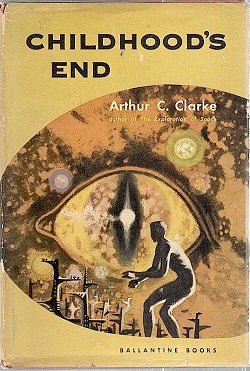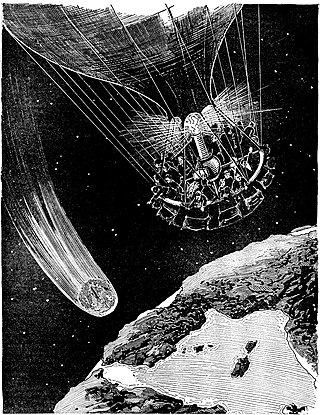
Childhood's End is a 1953 science fiction novel by the British author Arthur C. Clarke. The story follows the peaceful alien invasion of Earth by the mysterious Overlords, whose arrival begins decades of apparent utopia under indirect alien rule, at the cost of human identity and culture.

The planet Venus has been used as a setting in fiction since before the 19th century. Its opaque cloud cover gave science fiction writers free rein to speculate on conditions at its surface—a "cosmic Rorschach test", in the words of science fiction author Stephen L. Gillett. The planet was often depicted as warmer than Earth but still habitable by humans. Depictions of Venus as a lush, verdant paradise, an oceanic planet, or fetid swampland, often inhabited by dinosaur-like beasts or other monsters, became common in early pulp science fiction, particularly between the 1930s and 1950s. Some other stories portrayed it as a desert, or invented more exotic settings. The absence of a common vision resulted in Venus not developing a coherent fictional mythology, in contrast to the image of Mars in fiction.

The Collected Stories of Arthur C. Clarke, first published in 2001, is a collection of almost all science fiction short stories written by Arthur C. Clarke. It includes 114 stories, arranged in order of publication, from "Travel by Wire!" in 1937 through to "Improving the Neighbourhood" in 1999. The story "Improving The Neighbourhood" has the distinction of being the first fiction published in the journal Nature. The titles "Venture to the Moon" and "The Other Side of the Sky" are not stories, but the titles of groups of six interconnected stories, each story with its own title. This collection is only missing a very few stories, for example "When the Twerms Came", which appears in his other collections More Than One Universe and The View from Serendip. This edition contains a foreword by Clarke written in 2000, where he speculates on the science fiction genre in relation to the concept of short stories. Furthermore, many of the stories have a short introduction about their publication history or literary nature.

Saturn has made appearances in fiction since the 1752 novel Micromégas by Voltaire. In the earliest depictions, it was portrayed as having a solid surface rather than its actual gaseous composition. In many of these works, the planet is inhabited by aliens that are usually portrayed as being more advanced than humans. In modern science fiction, the Saturnian atmosphere sometimes hosts floating settlements. The planet is occasionally visited by humans and its rings are sometimes mined for resources.

Asteroids have appeared in fiction since at least the late 1800s, the first one—Ceres—having been discovered in 1801. They were initially only used infrequently as writers preferred the planets as settings. The once-popular Phaëton hypothesis, which states that the asteroid belt consists of the remnants of the former fifth planet that existed in an orbit between Mars and Jupiter before somehow being destroyed, has been a recurring theme with various explanations for the planet's destruction proposed. This hypothetical former planet is in science fiction often called "Bodia" in reference to Johann Elert Bode, for whom the since-discredited Titius–Bode law that predicts the planet's existence is named.
The fictional portrayal of the Solar System has often included planets, moons, and other celestial objects which do not actually exist. Some of these objects were, at one time, seriously considered as hypothetical planets which were either thought to have been observed, or were hypothesized to be orbiting the Sun in order to explain certain celestial phenomena. Often such objects continued to be used in literature long after the hypotheses upon which they were based had been abandoned.
Planets outside of the Solar System have been featured as settings in works of fiction. Most of these fictional planets do not vary significantly from the Earth. Exceptions include planets with sentience, planets without stars, and planets in multiple-star systems where the orbital mechanics can lead to exotic day–night or seasonal cycles.

The concepts of space stations and space habitats feature in science fiction. The difference between the two is that habitats are larger and more complex structures intended as permanent homes for substantial populations, but the line between the two is fuzzy with significant overlap and the term space station is sometimes used for both concepts. The first such artificial satellite in fiction was Edward Everett Hale's "The Brick Moon" in 1869, a sphere of bricks 61 meters across accidentally launched into orbit around the Earth with people still onboard.

"Transience" is a science fiction short story by English writer Arthur C. Clarke, first published in 1949 in the magazine Startling Stories. It was later collected in The Other Side of the Sky and The Nine Billion Names of God.
"Time's Arrow" is a science fiction short story by British writer Arthur C. Clarke, first published in 1950 in the first issue of the magazine Science Fantasy. The story revolves about the unintended consequences of using time travel to study dinosaurs.

"The Possessed" is a science fiction short story by British writer Arthur C. Clarke, first published in 1953.

More Than One Universe: The Collected Stories of Arthur C. Clarke is a collection of science fiction short stories by Arthur C. Clarke originally published in 1991.

Sir Arthur Charles Clarke was a British science fiction writer, science writer, futurist, inventor, undersea explorer, and television series host.
The following is a list of works by Arthur C. Clarke.

Comets have appeared in works of fiction since at least the 1830s. They primarily appear in science fiction as literal objects, but also make occasional symbolical appearances in other genres. In keeping with their traditional cultural associations as omens, they often threaten destruction to Earth. This commonly comes in the form of looming impact events, and occasionally through more novel means such as affecting Earth's atmosphere in different ways. In other stories, humans seek out and visit comets for purposes of research or resource extraction. Comets are inhabited by various forms of life ranging from microbes to vampires in different depictions, and are themselves living beings in some stories.
"Crusade" is a short story by English writer Arthur C. Clarke, first published in 1968 and later reprinted in The Wind from the Sun as well as The Collected Stories of Arthur C. Clarke.

The View from Serendip is a collection of essays and anecdotes by Arthur C. Clarke, first published in 1977. The pieces include Clarke's experiences with diving, Sri Lanka, his relationships with other science fiction authors such as Isaac Asimov, and other personal memoirs. There are also reproductions of past lectures, as well as speculations about things of scientific interest. The essay "The World of 2001" had been previously published in Vogue. It predicted the end of menial labor, due to automation and bio-engineered apes.

The far future has been used as a setting in many works of science fiction. The far future setting arose in the late 19th century, as earlier writers had little understanding of concepts such as deep time and its implications for the nature of humankind. Classic examples of this genre include works such as H.G. Wells' The Time Machine (1895) or Olaf Stapledon's Last and First Men (1930). Recurring themes include themes such as Utopias, eschatology or the ultimate fate of the universe. Many works also overlap with other genres such as space opera, science fantasy or apocalyptic and post-apocalyptic fiction.












